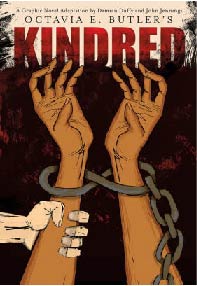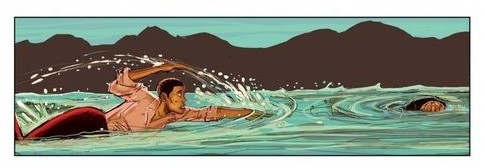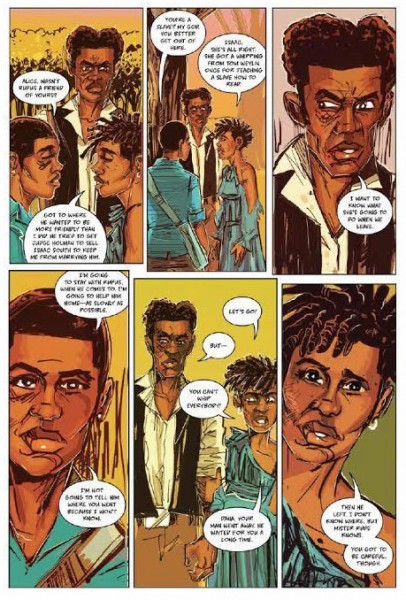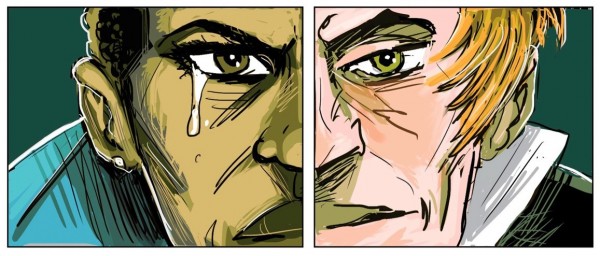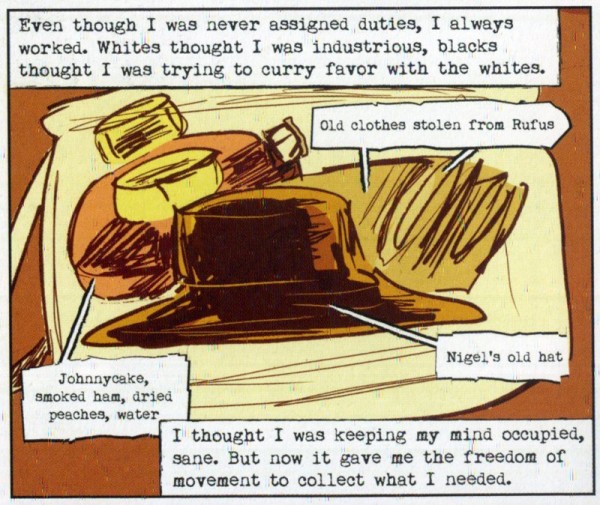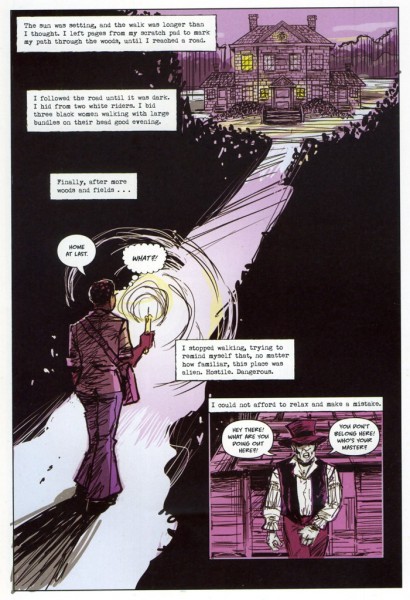Welcome to Using Graphic Novels in Education, an ongoing feature from CBLDF that is designed to allay confusion around the content of banned books and to help parents and teachers raise readers. In this column, we examine books that have been targeted by censors and provide teaching and discussion suggestions for the use of such books in classrooms.
In honor of Black History Month, we’re taking a closer look at Kindred: A Graphic Novel Adaptation by Octavia E. Butler, adapted by Damian Duffy, and illustrated by John Jennings (Abrams ComicArts, 2017). Known as “the grand dame of science fiction,” Butler’s work earned two Hugo Awards, two Nebula Awards, the PEN Lifetime Achievement Award, a MacArthur Foundation “Genius Grant”, and a Solstice Award. In addition, Butler is a 2010 inductee of the Science Fiction Hall of Fame. In the past 40 years, Butler’s works have experienced expanding popularity in both academia and popular culture. Kindred is one of her most widely used works in education, and the 2017 graphic novel adaptation of this 1979 classic won the 2018 Eisner Award for Best Adaptation from Another Medium and the 2018 Horror Writers Association Bram Stoker Award for Superior Achievement in a Graphic Novel.
Table of Contents
- OVERVIEW
- SUMMARY
- TEACHING/DISCUSSION SUGGESTIONS
- COMMON CORE STATE STANDARDS (CCSS)
- ADDITIONAL RESOURCES
OVERVIEW
Butler uses time travel and a complex cast of characters, living in two completely different time periods of American history, to address how race and gender have determined the distribution of power in various social systems throughout America’s history. The suggested age and grade level for this book is 13+ years and grades 8 and up; however, be aware that this book deals with difficult topics, like slavery, and as a result, the book contains some graphic imagery.
The Main Characters:
- Dana Franklin — The main protagonist, and African American female writer living in Los Angeles in 1976.
- Kevin Franklin — Dana’s white husband
- Rufus Weylin — Dana’s white ancestor
- Margaret Weylin — Rufus’s mother
- Tom Weylin — Rufus’s father
- Sarah — A house slave on the Weylin plantation; the cook
- Carrie — Sarah’s mute daughter
- Nigel — Carrie’s son; Sarah’s grandson
- Luke — Carrie’s husband; Nigel’s father
- Alice Greenwood Jackson — A former freedwoman, who Rufus buys and forces to sleep with him
- Isaac Jackson — Alice’s husband, a slave, who is caught and punished for running away
- Joe — Alice and Rufus’s son
- Hagar — Alice and Rufus’s daughter and Dana’s direct descendant
SUMMARY
Prologue
“I lost an arm on my last trip home.” The book opens with a single image of an African American woman (who we later discover is the protagonist, Dana) sitting up in a modern hospital bed. She has a look of disbelief and exhaustion on her face, and the bottom portion of her left arm is bandaged at the elbow.
The River
The chapter begins with a brief introduction to Dana and her husband, Kevin, who are moving into a new home in Los Angeles, CA, in 1976. When Dana has an unexplained episode, we are quickly taken from that reality as she travels to another place and time. She finds herself on a riverbank located in a lush, rural area. After saving a drowning boy named Rufus from a river and having a gun pulled on her for doing so, Dana returns to her house in LA. She is drenched, dirty, and scared. Kevin comforts her, but both are shaken by the experience.
The Fire
Dana attempts to go back to her day-to-day reality, but she is haunted by her experience at the river. She worries that she could be taken back at any time; her fears quickly become a reality when she has another episode while eating dinner with Kevin, and is taken back again. When she returns, she in Rufus’s bedroom; he is a little older and has set fire to the drapes. Dana quickly throws the burning curtains out the window; however, unlike the first visit, Dana does not return to 1976 right away. Rufus directs Dana to the cabin of a free black woman, who has a daughter named Alice. After some questioning, Dana realizes that Alice and Rufus might be her direct ancestors. Dana arrives at Alice’s home to find a group of white men dragging an African American family from the cabin. She hides and watches the men tie the father to a tree and beat him in front of his family. When the men leave, Dana helps the mother to bed and returns to the yard to get a blanket that was left there, but she finds that one of the white men has returned. He attacks Dana; she blacks out and returns to 1976. Kevin cares for her swollen eye, and she prepares a bag with items to help her if she time travels again.
The Fall
We learn that Dana met Kevin while working for a temp agency. When Dana becomes dizzy and begins to time travel, Kevin clings to her, and they both travel back in time. They find themselves in a clearing where they see Rufus, who has fallen from a tree and broken his leg. Dana and Kevin send Nigel, a young slave, to get help, and when help arrives, Dana and Kevin are taken back to the Weylin plantation. Because they cannot let anyone know that they are husband and wife, Kevin lies and says that Dana is his slave. Some time passes and the two fall into very separate routines on the plantation, seeing each other when they can. Before long, Dana begins teaching Nigel to read. One day, Weylin catches her with a book and beats her. She blacks out.
The Fight
When Dana comes to, she has returned to 1976 Los Angeles alone. The chapter opens with her remembering the only major argument that she and Kevin had before they got married. Dana is home for eight days before returning to the past. When she returns, years have passed, and she finds a much older Rufus being beaten up by an African American man. She learns the man is Alice’s husband, a slave named Isaac Jackson. Dana gets him to stop beating Rufus before Isaac kills him and talks Isaac and Alice to leave and let Dana take Rufus to his home. She walks to the Weylin plantation alone to get help. While nursing Rufus back to health, Dana learns that Kevin has left for the North. She asks Rufus to mail letters that she has written to Kevin, letting him know that she has returned to the time period. When Rufus’s health returns, he buys Alice. She has been badly beaten, and Dana nurses her back to health. Kevin returns. The chapter ends with Rufus attempting to stop Kevin from taking Dana.
The Storm
In the middle of the chaos, Kevin falls onto Dana and the two return to 1976 together, where Kevin struggles to fit back into modern society. Dana soon has another episode and travels back to the Weylin plantation. It is storming and she finds Rufus face down in a puddle. She saves him once again and discovers that six years have passed since her last visit, but Alice has not yet given birth to Hagar, Dana’s direct ancestor. Dana spends her time once again nursing Rufus back to health, but when Rufus’s father becomes sick and dies, Rufus blames Dana for not being able to save him and sends her to work in the fields. She doesn’t stay long. When Rufus sells a male slave for talking to Dana, she retaliates in the only way she knows she can; she slits her wrists.
The Rope
When Dana awakes, she has returned to 1976. She discovers, that although she had been in the past for eight months, she was only separated from Kevin for three hours. She remains with Kevin for 15 days before she is called back to the past again. She returns to find that Alice has hung herself because Rufus convinced her that he sold their children. After Alice’s funeral, Dana remains and convinces Rufus to free Joe and Hagar, his children with Alice, but she is unable to persuade him to free all of his slaves in his will. The chapter ends with Alice returning to 1976 after she stabs Rufus when he attempts to rape her.
Epilogue
Back in 1976, Dana and Kevin travel to Maryland in an attempt to make sense of their experiences. They search for records of her ancestors and discover two newspaper articles from the time. The first revealed that Rufus was thought to have died in a house fire, which Dana thinks was set by Nigel, one of Rufus’s slaves, in an attempt to cover up that Rufus had been stabbed. The second article lists the sale of slaves from the Weylin property; Nigel, Carrie, Joe, and Hagar are not listed as having been sold. Dana and Kevin travel into the Maryland countryside looking for where the Weylin property might have been, but they never locate it.
TEACHING AND DISCUSSION QUESTIONS
For Black History Month
- The novel is set in 1976, just a decade after the Civil Rights Movement. Research, read, review, and discuss the major events of the 1960s that would have affected Dana and Kevin’s life.
- The Civil Rights Act (signed into law in 1964);
- The 1964 American Civil Liberties Union lawsuit against the Los Angeles City Board of Education regarding de facto school segregation ;
- The 1965 Watts Riots.
- In an effort to gain a deeper understanding of the day to day experience of a slave in the Antebellum South, research and discuss African American writings and memoirs from the era (see below for resources).
- Many of the enslaved characters that Dana meets on Weylin’s plantation attempt to runaway. Sarah often refers to the violent incidents of runaway slaves as a reason for staying submissive on the Weylin plantation. Research and discuss what running away meant to those who attempted escape, to those who succeeded, to those who failed, and to those who remained behind (see resources below for examples of primary sources, such as pre-Civil War posters advertising rewards for the capture and return of runaway slaves).
Cultural Diversity, Civic Responsibilities, and Social Issues
- Analyze how the book’s different characters dealt with slavery. Discuss how slavery was an ingrained aspect of “culture” in early American life. For example, on page 87 two slave children are playing auction block (one child is pretending to auction off the other child). What other examples do the authors provide for the ways the institution of slavery infiltrated the day-to-day culture of both African Americans and whites living in the Antebellum South. What are Dana and Kevin’s reactions to this culture, and what’s the importance of their reactions? On page 213, Dana refers to Rufus as “a man of his time”; how does the institution of slavery effect Rufus’s world view, his belief system, and the choices he makes?
- Discuss the importance of education in the novel. How is being educated both a blessing and a curse for Dana when she time travels? Weylin’s violent reaction to Dana reading (and possibly teaching his other slaves to read) is an indication of his fear; why is he so threatened by the idea of a slave knowing how to read? In what ways does education equal power in the Antebellum South? How does education equal power for Dana in 1976 Los Angeles? Does education still equal power in today’s society? Why or why not?
- On page 34, we see the family tree that Dana’s grandmother, Hagar, kept in her Bible. Construct a family tree for each of the families we meet in the novel: Dana’s immediate family; Kevin’s immediate family; the Weylin family; Sarah’s family; and Alice Greenwood’s family. Compare and contrast family structures in 1976 (Dana’s and Kevin’s families) and family structures in the early 1800s (the Weylin family, Alice’s family, Sarah’s family, etc.). Discuss the role race plays in these family structures.
- On page 60, Dana states that she and her co-workers at a temp agency jokingly “called it a slave market, but it was really the opposite of slavery.” Compare and contrast the work Dana does at the temp agency with the work she does on Weylin’s plantation. Compare and contrast the attitudes of those in power in both places. Why would she and her co-workers jokingly call the temp agency a “slave market?”
Critical Reading and Making Inferences
The authors make many inferences in this book both with language use and through imagery. You may want to discuss the following uses of inference:
- When she first travels back in time, Dana must use clues to figure out where and when she has landed; as readers, we too must infer the time and place of Dana’s travels from the visual and verbal clues provided. How do Duffy and Jennings reveal the time period to us?
- On pages 57, 107, and 160, we see the contents of the bag Dana keeps close to her in case she time travels. We must assume that Dana has packed items that she feels will be valuable to her in the Antebellum South. Make a list of the contents contained in each of the bags. Discuss the relevance of each of the items, why they might be valuable to Dana, or how they may keep her (a modern African American woman) safe in her new setting (the Antebellum South). Are there items that would be less useful (or not useful at all) if she were an uneducated slave? What other items might she have included?
- Butler uses the concept of time travel to not only compare and contrast the reality of African Americans living during her own time with those of their enslaved ancestors living in the Antebellum South, but also explore the lingering effects of slavery on the lives of modern African Americans. Discuss how Duffy and Jennings’s adaptation shows us the drastic differences and subtle similarities between Los Angeles in 1976 and Maryland in the early 1800s. Compare and contrast:
- The lives of black and white children in Maryland before the Civil War;
- The lives of African American and white children in Los Angeles in the mid-1970s (use the resources below);
- The lives of slaves in the Antebellum South with the lives of African Americas in the 1970s;
- The lives of African Americans in the 1970s with the lives of African Americans today.
Language, Literature, and Language Usage
- On page 30, Dana is shocked by Rufus’s casual use of a derogatory term. Search for, define, and discuss the slang terms and idioms that are used to demean others in the novel. Compare and contrast the words used in the 1800s to the language used by Dana and Kevin’s coworker in the 1970s. How do those terms compare to terms used today to demean African Americans, Indigenous Peoples, Whites, Jews, Asians or any other “different” culture?
- The Epilogue explores how the use of language, particularly the use of written language, is linked to history. When Dana and Kevin return to Maryland in the 1970s looking for evidence of the people they had met in the 1800s, they were unable to find much information on the slaves they had met. Their lives were not recorded beyond a record of sale. How do public records reflect personal history? Why would having personal information available in public records be important?
Modes of Storytelling and Visual Literacy
In graphic novels, images are used to relay messages with and without accompanying text, adding additional dimensions to the story. Compare, contrast, and discuss with students how images can be used to relay complex messages. For example:
- Discuss the images used for each chapter title spread. What does each image reveal about the events to come?
- On page 119, we find Dana reaching the Weylin plantation after walking some distance. She has just returned to the Antebellum South for the fourth time to find Rufus being beat by Isaac Jackson and has had to walk some distance to get to the house. When she sees the lights in the distances, she says, “Home at last,” and then immediately questions her reaction. Later, in the chapter entitled, “The Storm,” after returning back to 1976 together Dana and Kevin discuss the strange sense of home they both feel at the Weylin plantation. Kevin stating that all the places he’s been (in the past and in their current time period) have “all felt [like] temporary stops along the way” and the “only place [he’s] felt at home in five years is the Weylin place.” Discuss how Jennings makes distinctions between the two settings in the narrative. How does Jennings’ choice of color reflect that Weylin’s place feels more like home? What is the importance of Dana and Kevin feeling more at home on Weylin’s plantation in the Antebellum South? Why is this feeling so jarring to Dana and Kevin?
- A map of Maryland is one of the items in Dana’s bag on page 57, and the layout on pages 74 and 75 incorporates a map. Discuss the importance of maps in the story. Why would a map be valuable to Dana in 1819 Maryland? How might Dana’s fictional experiences reflect the experiences of real people in the past? Why would maps be a valuable tool for an escaped slave in a time when most African Americans (slave or freed) could not read?
- This is an adaptation of a prose novel. Even if you do not choose (or have the time) to assign the original prose version, you can discuss the idea of adaptation.
- In her review of Kindred: A Graphic Novel Adaptation, Nalo Hopkinson praises the work for capturing “the essence of Octavia Butler’s vision even as it demonstrates the superlative skills of Damian Duffy and John Jennings.” Is it important for a graphic adaptation to “capture the essence” of the original work? Why or why not?
- Discuss the ways in which the graphic adaptation tells Octavia Butler’s story. For example, how do Duffy and Jennings use dialogue bubbles to propel the story? How does their use of typed narrative propel the narrative? How does the use of color express mood? Is there anything else about the art style or composition of the graphic novel that helps tell the story?
- In a prose novel, a character’s emotion is usually expressed outright in the text. In a graphic novel, emotion can be expressed through both written and visual components (speech bubbles/character dialogue, captions/narration boxes, the font with which terms are expressed, emanata/elements of body language, and the facial expressions of characters). Discuss how the graphic version of Kindred uses these various elements to express the emotions of characters.
- What are the purpose of the Prologue and Epilogue? Both sections are brief (1–3 pages), but they reveal a great deal of information, and one might say that the use of visual elements allowed Duffy and Jennings to accomplish this feat. Discuss the role that the visual aspects of the graphic adaptation play in conveying the message of the Prologue and Epilogue. What information is revealed in each section? What is the importance of each section to the story? How is the information in each section revealed to the reader?
Suggested Prose Novel and Poetry Pairings
For greater discussion on literary style and/or content here are some prose novels, graphic novels, memoirs, and graphic memoirs you may want to read with Kindred: A Graphic Novel Adaptation.
- Kindred by Octavia E. Butler.
- Nat Turner by Kyle Baker — This work depicts the violent rebellion led by escaped slave Nat Turner.
- Beloved by Toni Morrison — Set in 1873, this novel depicts the life of Sethe, a former slave, who attempted to escape before the Civil War and when found by her master killed her child to save her from slavery. The spirit of the child supernaturally appears as a woman and feeds off of Sethe.
- Uncle Tom’s Cabin by Harriet Beecher Stowe — Originally, published in 1852, this anti-slavery novel is said to help lay the foundation for the Civil War. During her time, Stowe was lauded for her graphic depiction of the effects of slavery on African Americans; however, the saintly nature of her enslaved protagonist, Uncle Tom, led his name to develop a negative connotation over the years. Today the term, “Uncle Tom,” is an insult that refers to a subservient African American individual who is complicit with and protective of the racist systems that keep white people in power.
- Incidents in the Life of a Slave Girl by Harriet Jacobs — In this slave narrative, originally published in 1861, we get the firsthand account of Harriet Jacobs’ life as a mother and fugitive slave and one of the few extant narratives of slavery written by a woman.
- Roots by Alex Haley — Traces his family’s origin to an African village.
- Bullwhip Days the Slaves Remember by James Mellon — A compilation of stories told by former slaves in their own voices as they recount the harsh realities of slavery.
- Unspoken: A Story from the Underground Railroad by Henry Cole — A wordless story of a farm girl who discovers a runaway slave hiding in their barn.
- To Be a Slave by Julius Lester — A powerful collection of narratives gathered from slaves and former slaves.
- Amistad: A Long Road to Freedom by Walter Dean Myers — About the slave ship Amistad and how it was grounded after captured Africans on board took control of the ship. Myers uses archival documents while exploring the social and legal ramifications of this event.
- Breaking the Chains: African American Slave Resistance by William Loren Katz — Examines active and passive means used by black men and women as they dealt with the hardships and realities of slavery.
- The Slave Dancer by Paula Fox — An award-winning book about Jessie Collier, who is kidnapped and dumped on board a slave ship, where he must play his fife to keep the slaves dancing, ensuring their muscles and bodies are fit for sale. Jessie must learn to face the horrors and hazards of life onboard The Moonlight.
- Sarny: A Life Remembered by Gary Paulsen — About a woman, Sarny, who gains her freedom and searches for the children who were stripped from her and sold before the Civil War.
- The Silence of Our Friends by Mark Long, Jim Demonakos, and Nate Powell (First Second Books, 2012) — A semi-autobiographical story of Mark Long’s childhood experiences in Houston, Texas, 1968, centering around the Texas Southern University student boycott after the Student Nonviolent Coordinating Committee (SNCCC) was banned from its campus.
- P.S. Be Eleven by Rita Williams-Garcia — Winner of the Loretta Scott King Award (2013) and sequel to One Crazy Summer (Newbery Honor Book), this book reveals race, gender, and political issues of the late 1960s.
- To Kill a Mockingbird by Harper Lee — An American classic about a town struggling with racism and a trial that brings two families from opposing sides of the Civil Rights conflict to the forefront.
- To Kill a Mockingbird by Harper Lee — The graphic adaptation of Harper Lee’s classic novel.
- March Book One by Congressman John Lewis, Andrew Aydin and Nate Powell — This first volume spans Lewis’ youth in rural Alabama, his meeting with Dr. Martin Luther King Jr., the birth of the Nashville Student Movement, and their battle against segregation. NOTE: This book has an awesome teacher’s guide too.
- Coming of Age in Mississippi by Anne Moody — An autobiography of a poor Black girl whose parents were tenant farmers on a Mississippi plantation and whose dream of going to college was realized upon winning a basketball scholarship. We get first-hand accounts of her joining the NAACP, CORE, and SNCC, and the steps she took in demonstrations and sit-ins, along with her subsequent arrests and jailings.
- Through My Eyes: Ruby Bridges by Ruby Bridges, Margo Lundell (Editor) — Ruby Bridges chronicles her steps in November 1960 as a six-year-old black girl, surrounded by federal marshals as she walked through a mob of screaming segregationists into her school.
COMMON CORE STATE STANDARDS (CCSS)
Kindred: A Graphic Novel Adaptation is full of advanced vocabulary, eloquent oratory, witness dialogues, and street dialect and slang. It promotes critical thinking as readers must construct the reality of two very different time periods and navigate the ways in which American identity, culture, and social norms have shifted throughout our nation’s history. Furthermore, its graphic novel format provides verbal and visual storytelling, which not only addresses multi-modal teaching, but also meets the following Common Core State Standards:
- Knowledge of Language: Apply knowledge of language to understand how language functions in different contexts, to make effective choices for meaning or style, to comprehend more fully when reading or listening.
- Vocabulary Acquisition and Use: Determine or clarify the meaning of unknown and multiple-meaning words and phrases by using context clues, analyzing meaningful word parts, and consulting general and specialized reference materials; demonstrate understanding of figurative language, word relationships, and nuances in word meaning; acquire and use accurately a range of general academic and domain-specific words and phrases sufficient for reading, writing, speaking and listening at the college and career readiness level.
- Key ideas and details: Reading closely to determine what the texts says explicitly and making logical inferences from it; citing specific textual evidence when writing or speaking to support conclusions drawn from the text; determining central ideas or themes and analyzing their development; summarizing the key supporting details and ideas; analyzing how and why individuals, events, or ideas develop and interact over the course of the text.
- Craft and structure: Interpreting words and phrases as they are used in a text, including determining technical, connotative, and figurative meanings and analyzing how specific word choices shape meaning or tone; analyzing the structure of texts, including how specific sentences, paragraphs and larger portions of the text relate to each other and the whole; assessing how point of view or purpose shapes the content and style of a text.
- Integration of knowledge and ideas: Integrate and evaluate content presented in diverse media and formats, including visually as well as in words; delineate and evaluate the argument and specific claims in a text, including the validity of the reasoning as well as the relevance and sufficiency of the evidence; analyze how two or more texts address similar themes or topics in order to build knowledge or to compare the approaches the authors take.
- Range of reading and level of text complexity: Read and comprehend complex literary and informational texts independently and proficiently.
- Research to Build and Present Knowledge: Conduct short as well as more sustained research projects based on focused questions, demonstrating understanding of the subject under investigation; gather relevant information from multiple print and digital sources, assess the credibility and accuracy of each source, and integrate the information while avoiding plagiarism; draw evidence from literary or informational texts to support analysis, reflection, and research.
- Comprehension and collaboration: Prepare for and participate effectively in a range of conversations and collaborations with diverse partners, building on others’ ideas and expressing their own clearly and persuasively; integrate and evaluate information presented in diverse media and formats, including visually, quantitatively and orally; evaluate a speaker’s point of view, reasoning, and use of evidence and rhetoric.
- Presentation of knowledge and ideas: Present information, findings, and supporting evidence such that listeners can follow the line of reasoning and the organization; adapt speech to a variety of contexts and communicative tasks, demonstrating command of formal English when indicated or appropriate.
This book and related discussions also cover the following themes identified by The National Council for the Social Studies:
- Culture and Cultural Diversity — “…students need to comprehend multiple perspectives … to consider the strengths and advantages that this diversity offers to the society in general and to their own growth…to analyze the ways that a people’s cultural ideas and actions influence its members…”
- Time, Continuity, and Change — “…facilitate the understanding and appreciation of differences in historical perspectives and the recognition that interpretations are influenced by individual experiences, societal values, and cultural traditions… examine the relationship of the past to the present and extrapolating into the future… provide learners with opportunities to investigate, interpret, and analyze multiple historical and contemporary viewpoints within and across cultures related to important events, recurring dilemmas, and persistent issues, while employing empathy, skepticism, and critical judgment…”
- Individual Development and Identity — “…describe how family, religion, gender, ethnicity, nationality, socioeconomic status, and other group and cultural influences contribute to the development of a sense of self…have learners compare and evaluate the impact of stereotyping, conformity, acts of altruism, discrimination, and other behaviors on individuals and groups…”
- Individuals, Groups, and Institutions — “…help learners understand the concepts of role, status, and social class and use them in describing the connections and interactions of individuals, groups, and institutions in society…analyze groups and evaluate the influence of institutions, people, events, and cultures in both historical and contemporary settings…identify and analyze examples of tensions between expressions of individuality and efforts of groups and institutions to promote social conformity…”
- Power, Authority, and Governance — “…understanding the historical development of structures of power, authority, and governance and their evolving functions in contemporary American society… enable learners to examine the rights and responsibilities of the individual in relation to their families, their social groups, their community, and their nation… examine issues involving the rights, roles, and status of individuals in relation to the general welfare…explain conditions, actions, and motivations that contribute to conflict and cooperation within and among nations…challenge learners to apply concepts such as power, role, status, justice, democratic values, and influence…”
- Civic Ideals and Practices — “…assist learners in understanding the origins and continuing influence of key ideals of the democratic republican form of government, such as individual human dignity, liberty, justice, equality, and the rule of law…analyze and evaluate the influence of various forms of citizen action on public policy…evaluate the effectiveness of public opinion in influencing and shaping public policy development and decision-making…”
ADDITIONAL RESOURCES
- Kindred Teaching Guide. Abrams Books provides a teacher’s guide for Kindred on their website.
- Race Relations in America: Digital Primary Resources. A digital archive of the surveys and papers from The Amistad Research Center, 1943–1970, which includes over 100 hours of audio recordings of speeches given by prominent members of the Civil Rights Movement, eminent sociologists, economists, industrial experts, and psychologists.
- The Valley of the Shadow: Two Communities in the American Civil War. A digital archive of primary sources that document the lives of people in Augusta County, Virginia, and Franklin County, Pennsylvania, years directly before, during, and just after the American Civil War. The archive includes thousands of letters, diary entries, newspaper articles, speeches, and census, church, and county records.
- Daily Lives of Slaves – What Really Happened?. A lesson plan provided by the University of Maryland Baltimore County’s Center for History Education, which includes primary resources about life in the Antebellum South (including first-hand accounts and slave narratives) and handouts for evaluating and discussing primary sources.
- PBS’s Africans in America. A four-part series that each focuses on an individual slave narrative and includes other primary sources and a teacher’s guide.
- The African-American Mosaic: A Library of Congress Resource Guide for the Study of Black History & Culture. Part of a Library of Congress exhibit, this site includes antislavery petitions and other original sources documenting the struggle to abolish slavery.
- Images of African Americans from the 19th Century. A selection of visual resources from the New York Public Library’s Schomberg Center Digital Collections.
- Born in Slavery: Slave Narratives from the Federal Writers’ Project, 1936 to 1938. The first-hand accounts of former slaves gathered for the Depression-era Federal Writers’ Project.
- PBS: Slavery and the Making of America: Detailing slavery practices and slave memories; includes information about runaways in the slave community, gender issues experienced by slaves, videos, teaching suggestions
- Scholastic’s resources: The Underground Railroad: Escape from Slavery: Students can follow escaped slaves in 1860; there are slideshows, primary sources, activities, teachers guide, myths uncovered, and Underground Railroad videos.
Please help support CBLDF’s important work by making a donation or becoming a member of CBLDF!
